Managing the financial aspects of a manufacturing business involves paying close attention to many...
Complete Guide to Accrual Accounting for Manufacturers

Manufacturing isn’t just about machining parts or assembling products—it’s also about maintaining financial discipline. A minor misstep in your accounting can magnify over time, eroding profits and causing cash shortages. That’s why understanding accrual accounting is critical. This guide explains what the accrual method is, how it differs from cash accounting and why it gives manufacturing companies a clearer picture of profitability. You’ll also learn how to implement accrual accounting effectively and leverage your numbers to make better decisions.
Understanding the Basics: What Is Accrual Accounting?
At its core, accrual accounting records revenue when it’s earned and expenses when they’re incurred—not when cash changes hands. This method “provides a more accurate picture of a company's financial health than cash accounting” because it follows the matching principle, aligning revenues and expenses in the same period . For example, if you deliver a machine in December but receive payment in January, accrual accounting records the sale in December, ensuring your December financials reflect the work you performed.
The alternative is cash accounting, which recognizes transactions only when money is received or paid out. While simple, cash accounting can distort profitability; a profitable month could look unprofitable if invoices remain unpaid, or vice versa. Accrual accounting mitigates this by recognizing obligations and rights as they arise.
Why Do Manufacturers Use Accrual Accounting?
Most manufacturers carry inventory and extend credit to customers, meaning accrual accounting is usually mandatory. Companies with average revenues above US$25 million over three years must use the accrual method. Even smaller firms often adopt it voluntarily because it meets Generally Accepted Accounting Principles (GAAP). When you’re starting a business you can choose between cash or accrual accounting, but accrual “aligns with GAAP-based accounting best practices, offering a structured framework”. That structure helps attract lenders and investors, who expect accurate, GAAP‑compliant financial statements.
Matching Revenue and Expenses
Accrual accounting applies the matching principle, ensuring that you recognize expenses in the same period as the revenue they helped generate. For example, raw materials purchased in September for a job delivered in October are recorded as cost of goods sold in October—not September. This alignment is vital for manufacturing firms, where production cycles can span weeks or months. Proper matching allows you to calculate gross margin accurately and identify profitable product lines.
Accrual vs. Cash: A Quick Comparison
While the cash method might appeal to micro‑businesses for its simplicity, accrual accounting offers superior insight.
Why Accrual Accounting Matters to Manufacturers
1. Clearer Profitability
Revenue is important, but Profitable strategies is what truly matters. A company can have high sales and still lose money . Accrual accounting ties each sale to its related costs, giving you a realistic view of margins. You can break down expenses into fixed vs. variable and direct vs. indirect , then use cost‑volume‑profit analysis to see how changes in volume affect profits . Without accrual records, these analyses are impossible.
2. Better Decision‑Making
Accrual accounting produces financial statements that lenders and investors trust . Accurate income statements, balance sheets and cash flow statements help you decide whether to invest in new equipment, adjust pricing or pursue financing. With real‑time visibility into payables and receivables, you’ll avoid surprises at month’s end and ensure cash doesn’t run out even when profits look strong.
3. Enhanced Compliance and Governance
Adhering to GAAP means more than just good form—it protects you from regulatory penalties . Manufacturers often operate in regulated industries where proper revenue recognition and cost allocations are essential. Accountants with deep knowledge of accrual accounting and internal controls help businesses adhere to regulations and avoid penalties . A robust accounting system also simplifies audits and improves investor confidence.
4. Informed Risk Management
Financial risks lurk everywhere—market fluctuations, supply chain disruptions, cash‑flow shortfalls, regulatory changes and equipment breakdowns. Accrual accounting provides early warnings. By tracking outstanding receivables and accrued expenses, you can identify cash shortages before they become crises. Manufacturers who proactively address risks reduce financial losses by up to 30% and are better prepared to withstand market volatility .
5. Precise Cost Control and Pricing
Manufacturing profitability hinges on knowing your costs. Jobs that seem profitable can drain cash if overhead allocations or labor costs are inaccurate. Implementing financial software or ERP systems improves visibility and consistency in labor and overhead monitoring. With accurate accrual records, you can update pricing based on actual costs, maintain competitiveness and protect margins.
Implementing Accrual Accounting: Step‑by‑Step
Switching from cash to accrual accounting—or starting accrual accounting from day one—requires planning. Below is a roadmap tailored for manufacturers:
- Evaluate Current Processes:
Map your existing billing, inventory and expense workflows. Identify areas where transactions are recorded only when cash changes hands. Involve stakeholders from finance, production and procurement to ensure nothing is overlooked. - Select the Right Tools:
Manual bookkeeping is slow and error‑prone. Companies switching to automation cut operational costs by up to 20% . Look for integrated accounting software or ERP systems that can handle accrual entries, automate data capture and provide real‑time reporting. Automation reduces errors and ensures you capture transactions when they occur. - Set Up Chart of Accounts and Policies:
Define revenue and expense categories that align with your manufacturing processes. Establish policies for recognizing revenue (e.g., upon delivery or customer acceptance) and expenses (e.g., when materials are received). Document these procedures in an accounting manual to ensure consistency across the team. - Train Your Team:
Employees on the shop floor and in the office need to understand why accrual accounting matters. Provide training on capturing work‑in‑process costs, tracking labor hours and recording accruals. Emphasize how timely and accurate data entry supports better decision‑making and profitability. - Implement a Phased Transition:
If you’re switching from cash accounting, start by recording receivables and payables on an accrual basis while continuing to file taxes on a cash basis (in jurisdictions that allow hybrid methods). Gradually expand to inventory accounting, job costing and overhead allocations. - Monitor and Adjust:
Conduct regular reviews of accrual entries and reconcile them against actual cash receipts and payments. Use monthly financial statements to spot discrepancies, adjust estimates and refine your processes. Routine audits and internal controls will strengthen accuracy and compliance.
Integrating Accrual Accounting with ERP Systems
Enterprise Resource Planning systems act as the central hub connecting finance, purchasing, inventory and production. Implementing an ERP helps automate accrual entries, track work‑in‑process and manage job costing. Adopting an ERP improves labor cost control and ensures resources are used efficiently. When integrated properly, an ERP reduces manual data entry, standardizes processes and accelerates month‑end close.
Using Accrual Data for Deeper Insights
Cost‑Volume‑Profit (CVP) Analysis
Once you’re recording revenues and costs when they occur, you can leverage powerful analytical tools. Cost‑volume‑profit analysis helps determine how changes in sales volume affect profit. A CVP graph plots fixed costs, total costs and total sales; the point where total sales equal total costs is the break‑even point. Below that point the company operates at a loss, and above it each additional sale contributes to profit. This visualization is invaluable when considering price changes, production expansions or new product lines. By using accrual data, your CVP analysis reflects true costs and revenues, not just cash movements.
Pricing and Profitability Analysis
Accrual accounting also aids in profit analysis at the product and customer level. Breaking down costs into categories and using CVP analysis and financial KPIs to understand break‑even points. Tracking product‑level profitability helps you decide which items to promote, which to reprice and which to discontinue. When combined with accrual data, this analysis highlights where margins are eroding due to high overhead or production inefficiencies.
Cash Flow Forecasting
While accrual accounting focuses on revenues and expenses, cash remains king. Because accrual statements can show profit even when cash is tight, manufacturers should complement accrual reporting with cash flow forecasts. Monitoring accounts receivable aging, payment terms and inventory turnover ensures that you have sufficient liquidity to meet payroll and pay suppliers. Automation tools can provide real‑time updates on cash balances, eliminating the lag of manual spreadsheets.
Challenges and Considerations
Complexity and Cost
Accrual accounting is more complex than cash accounting and may require professional help. It demands meticulous recordkeeping, accurate accrual estimates and regular reconciliations. Training costs and software expenses can be significant. However, the long‑term benefits in terms of financial clarity and improved decision‑making far outweigh the initial investment.
Data Entry and Human Error
Manual data entry can introduce errors that distort financial statements. Automation mitigates this risk, reducing errors and improving efficiency . Automated systems speed up processing and eliminate mistakes, enabling manufacturers to monitor cash flow in real time.
Transitioning from Cash to Accrual
Switching methods can be challenging. You’ll need to restate prior-period financials for comparability, adjust tax filings and educate stakeholders. Work closely with a CPA to ensure proper treatment of existing receivables, payables and inventory balances. Allocating time and resources upfront will ease the transition and reduce disruption.
Managing Cash Even When Profit Looks Good
Accrual accounting may show a profit even when there’s not enough cash to pay bills. To avoid cash crunches, maintain a cash flow forecast alongside your accrual financials and enforce strict accounts receivable collections. Our financial risk management post highlights common threats like late payments, market fluctuations and supply chain disruptions , reminding manufacturers to build cash reserves and strengthen your financial risk management strategies.
Final Thoughts: Accrual Accounting as a Foundation for Growth
Accrual accounting isn’t just an accounting method—it’s a strategic tool for manufacturers who want to grow profitably. By recording revenue and expenses when they occur, you gain clear insight into profitability, cash flow and operational efficiency. You can use data to set prices confidently, plan production, manage labor costs and anticipate financial risks.
The path to accrual accounting may seem daunting, but with the right guidance and tools, the payoff is substantial. Adopt integrated systems, automate manual tasks and invest in training to build a robust accounting framework. Combine accrual reporting with analytical tools like cost‑volume‑profit analysis to understand the drivers of profitability. And remember: while accrual accounting improves transparency, proactive cash management and risk planning remain essential for stability.
For more insights on streamlining your financial operations and improving profitability, explore our related resources on integrated accounting systems, labor cost control and pricing and financial forecasting. Armed with accurate data and expert advice, your manufacturing business can thrive in any market condition.







